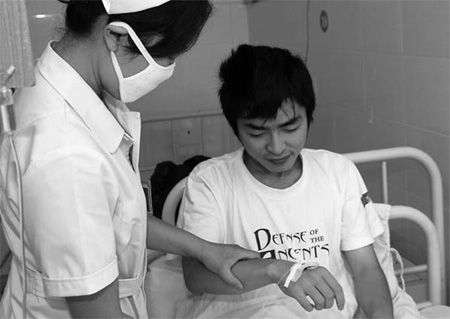Society
Residents blame polluted river for diarrhea
Updated: 2011-07-11 07:55
By Liu Xiangrui (China Daily)
|
Wu Bo, a student in Xinyang, Henan province, receives treatment for diarrhea at Huangchuan People's Hospital on Saturday. Xiang Mingchao / China Daily |
XINYANG, Henan - Residents in Huangchuan county have blamed tainted drinking water from Xiaohuanghe River for a recent widespread bout of diarrhea and have questioned official statistics on the number of people affected.
"From what I know, there are many more people in Huangchuan (county) suffering diarrhea than the official number of 294," said a man surnamed Zhang, 29, who did not want his full name used as he works with the government.
Seven of the eight people in Zhang's family have been ill for more than a month, he said, adding that many of his neighbors have had the same problem. He even started a thread on an Internet forum to find diarrhea patients to counter the official figure.
Residents in Huangchuan, Henan province, have seen an outbreak of diarrhea since mid-June, leaving hospitals and clinics jammed with patients and pharmacies running out of relevant drugs, Dahe Daily reported on Friday. However, officials have denied this.
According to a statement from the county's health bureau, there were 294 cases of diarrhea between Jan 1 and July 7 this year, "a noticeable increase of 53.6 percent compared with the same period last year".
Gao Jixian, director of the bureau, failed to provide an overall figure for the county, as "those who didn't go to the hospital for treatment were not included in our report to higher authorities".
Many residents attribute the outbreak of diarrhea to unclean tap water provided by a company that uses the polluted Xiaohuanghe River as a source.
"The water was so disgusting. It was too dirty for washing clothes, let alone drinking," said 67-year-old Yang, a resident living by the river who refused to give her full name.
Yang has been suffering diarrhea for about 10 days and has recently bought a water purifier for about 2,000 yuan ($309). The water was yellow-black, and sometimes had dead mosquitoes and tiny floating things in it, said Yang. "We had to wait a long time for it to settle before using it."
She said the intake of the water plant is downstream from a heavy-polluting factory, while sewage of citizens along the river is poured into the waterway without any treatment.
Unprecedented drought this year dried up the reservoir, the town's former source of water, said Liu Jianhua, director of Huangchuan's utilities service center, which manages the water supply system. This prompted the authorities in May to start a new supply using a nearby water plant built in 1979 and closed since late 2008.
"We had no other choices," Liu explained. "It's a temporary approach to restart supply using this water source."
The plant temporarily cut water supply from Friday evening until late Saturday for "a water-processing advancement", explaining to residents that its water met national standards for drinking before the advancement and that residents had no cause for concern.
Liu said authorities wanted to improve water quality by increasing the residual chlorine in the running water along with the capacity of the plant, which serves 80,000 of the town's more than 300,000 residents.
The control of the water source is "the environmental protection bureau's business", added Liu. "We carried out an overhaul on facilities before we reopened the plant."
Wang Jianjun, director of the county's environmental protection bureau, declined China Daily's request for an interview.
An expert panel formed by members from Henan's center for disease control and prevention and its health department arrived in Huangchuan on Friday to double-check reports that thousands had fallen victim to the epidemic.
According to Xu Bianli, deputy director of the disease control center and head of the panel, experts collected tap water samples from homes and the plant, as well as stool samples from two diarrhea patients. The results are expected in several days.
Xu said the epidemic is most likely the result of the "instability" in the water quality due to its high turbidity after sharp rain in the upper end of the river, and the fact that it is currently peak season for diarrhea.
Xu explained that the panel members did not check the alleged pollution in the water plant's intake because pollution is something they cannot control.
Zheng Qingming, dean of the infectious disease center at the Huangchuan County People's Hospital, told China Daily on Saturday it had received 59 diarrhea patients since May 1, which he thought was "slightly higher than previous years", and their symptoms were not different from past cases of diarrhea.
"Actually, not that many people received treatment here apart from the aged or pregnant," he said, adding that patients usually go to private clinics for simpler treatments.
A saleswoman surnamed Zhang at Jiankang Pharmacy said common medicines for diarrhea have been in demand recently, and some had sold out several days ago before the shop replenished their stock.
"What's strange with diarrhea cases this year is that many patients say they have some post-cure syndromes that last a long time, including loss of appetite, nausea and flatulence," said practitioner Zhou Guojun, who owns a clinic that mainly treats children at Aiguo Xincun community. In his clinic, eight of the 23 patients receiving drips there on Saturday were suffering diarrhea.
"The number of diarrhea patients started to increase early in June, and began to peak soon after mid-June," Zhou said.
"Around the end of June, there were about 20 diarrhea patients a day at my clinic; the situation is better now," said Practitioner Wang, 65, whose clinic on the edge of the downtown area treated 11 patients for diarrhea on Saturday.
"Many blame the unclean tap water for the diarrhea, but we can't judge so quickly, because many residents in this district who use water from deep wells have also had diarrhea," he said.
Wang suggested the disease was contagious and had some symptoms that were different from recent cases of diarrhea.
"Many patients don't feel great pain in the abdomen and sometimes antibiotics don't work," he said.
Li Yuefeng and Pan Ya'nan contributed to this story.
China Daily
(China Daily 07/11/2011 page5)
E-paper

Burning desire
Tradition overrides public safety as fireworks make an explosive comeback
Melody of life
Demystifying Tibet
Bubble worries
Specials

90th anniversary of the CPC
The Party has been leading the country and people to prosperity.

Say hello to hi panda
An unusual panda is the rising star in Europe's fashion circles

My China story
Foreign readers are invited to share your China stories.

